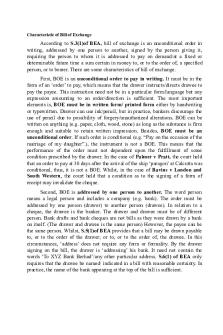Augustus of Primaporta PDF

| Title | Augustus of Primaporta |
|---|---|
| Course | Art Historical Studies 1 |
| Institution | University of Guelph |
| Pages | 2 |
| File Size | 93.9 KB |
| File Type | |
| Total Downloads | 91 |
| Total Views | 145 |
Summary
One of the essay questions for the second midterm, deals with the Primaporta and its cultural significance as a piece of work in the modern era and why it is so famous....
Description
Augustus of Primaporta. Early 1st century CE; perhaps a copy of a bronze statue of c. 20 BCE. Marble, originally colored, height 6'8" (2.03 m). Musei Vaticani, Braccio Nuovo, Rome. This sculpture, known as Augustus of Primaporta because it was discovered in a villa at Primaporta near Rome, is a prime early example of Roman Imperial propaganda. It combines earlier Greek and Roman sculptural traditions with mythological references, resulting in an idealized, yet recognizable, commemorative depiction of the first Roman emperor. This sculpture commemorates Augustus, the first Roman emperor, using a new form of Roman idealism well-suited to the celebration of the extended period of peace and prosperity that Rome experienced during the age of Augustus. Augustus, born Octavian in 63 BCE, came to rule in 44 BCE after the murder of his uncle Julius Caesar. Over the next 17 years, as general, politician, statesman, and public-relations genius, Octavian vanquished warring internal factions and brought peace to fractious provinces. By 27 BCE, the Senate had conferred on him the title of Augustus (meaning “exalted” or “sacred”). During the 45 years that Augustus led the state and empire, he established efficient rule and laid the foundation for an extended period of stability, domestic peace, and economic prosperity. This period, known as the Pax Romana (“Roman Peace”), lasted over 200 years (from 27 BCE to 180 CE). The Pax Romana saw the development of building and administration programs of unprecedented scale and complexity, which helped facilitate the development and administration of the empire. Augustus and his successors relied heavily on imperial propaganda to promote and maintain their power. Roman artists developed a new propagandistic style—a form of Roman idealism that, although grounded in the appearance of the everyday world, was heavily influenced by a revival of Greek Classical ideals and rooted in powerfully traditional stories. This Roman idealism was widespread in official images and records of contemporary historical events on public monuments, as well as in representations of private individuals. Cupid, son of the goddess Venus, rides a dolphin next to the emperor’s right leg. His presence is a reference to the claim of the emperor’s family, the Julians, to descend from the goddess Venus through her human son Aeneas. Augustus’s cuirass (torso armor) is covered with figural imagery, which represents his military victories and the resulting peace. Mid-torso is a scene representing Augustus’s diplomatic victory over the Parthians in 20 BCE; a Parthian (on the right) returns a Roman military standard to a figure variously identified as a Roman soldier or the goddess Roma. Looming above this scene at the top of the cuirass is a celestial deity who holds an arched canopy, implying that the peace signified by the scene below has cosmic implications. The personification of the earth at the bottom of the cuirass holds an overflowing cornucopia, representing the prosperity brought by Augustan peace. The Augustus of Primaporta was greatly influenced by the work and ideas of the Greek High Classical sculptor Polykleitos, who developed an ideal canon of proportions for the male figure. These ideal proportions, which are exemplified in his Spear Bearer, shown here, are echoed in the athletic figure of Augustus.
Augustus’s stance, in which his weight is shifted onto his right leg, also comes from Greek Classical sculpture. This convention of presenting standing figures with opposing alternations of tension and relaxation around a central axis is called "contrapposto." Like heroic figures in Greek sculpture, Augustus is depicted as if he is in the physical prime of youth. Although Augustus lived to almost age 76, in his portraits he is always shown as a young, vigorous ruler. Augustus’ pose, with arm raised as if he is about to address a gathering, is drawn from the sculptural traditions of the Roman Republic, as seen in this comparison with the sculpture of the official Aulus Metellus from about 80 BCE. The pose is expressive of the rhetorical persuasiveness and authority of the subject. Although possessing idealized youthfulness, Augustus’s face is rendered with detailed features that make this portrait an easily recognizable likeness. This emphasis on accurate portraiture represents a distinctly Roman custom that may be connected to early Roman practices of creating likenesses of revered figures and distinguished ancestors for display on public occasions....
Similar Free PDFs

Augustus of Primaporta
- 2 Pages

Tentamen augustus 2009, uitwerking
- 11 Pages

Augustus Oklahoma recensie
- 3 Pages
Popular Institutions
- Tinajero National High School - Annex
- Politeknik Caltex Riau
- Yokohama City University
- SGT University
- University of Al-Qadisiyah
- Divine Word College of Vigan
- Techniek College Rotterdam
- Universidade de Santiago
- Universiti Teknologi MARA Cawangan Johor Kampus Pasir Gudang
- Poltekkes Kemenkes Yogyakarta
- Baguio City National High School
- Colegio san marcos
- preparatoria uno
- Centro de Bachillerato Tecnológico Industrial y de Servicios No. 107
- Dalian Maritime University
- Quang Trung Secondary School
- Colegio Tecnológico en Informática
- Corporación Regional de Educación Superior
- Grupo CEDVA
- Dar Al Uloom University
- Centro de Estudios Preuniversitarios de la Universidad Nacional de Ingeniería
- 上智大学
- Aakash International School, Nuna Majara
- San Felipe Neri Catholic School
- Kang Chiao International School - New Taipei City
- Misamis Occidental National High School
- Institución Educativa Escuela Normal Juan Ladrilleros
- Kolehiyo ng Pantukan
- Batanes State College
- Instituto Continental
- Sekolah Menengah Kejuruan Kesehatan Kaltara (Tarakan)
- Colegio de La Inmaculada Concepcion - Cebu












